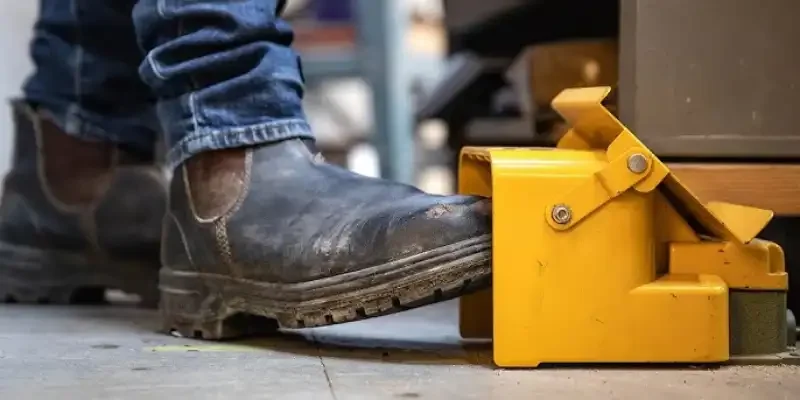Будь-який досвідчений столяр або майстер знає, що наявність правильних інструментів та аксесуарів може мати велике значення для роботи в майстерні. Одним з часто не помічених, але неймовірно корисних елементів обладнання є скромний ножний вимикач. Давайте зануримося у світ ножних вимикачів і дізнаємося, як вони можуть покращити ваш досвід роботи з електроінструментом.
Що таке ножний перемикач?
Ножний вимикач - це простий, але геніальний пристрій, який дозволяє керувати роботою електроінструменту за допомогою ноги, а не рук. Ножні вимикачі зазвичай використовуються в деревообробних майстернях, металообробних студіях та на промислових підприємствах і дозволяють керувати такими інструментами, як фрези, циркулярні пилки, свердлильні преси та токарні верстати без допомоги рук.
Ножний перемикач VIOX
У цій статті ми детально розглянемо ножний вимикач VIOX (TFS-302). Цей миттєвий ножний вимикач призначений для використання з різними електроінструментами. Ви можете знайти більше інформації про цей продукт ТУТ: VIOX Ножний перемикач.
Основні характеристики:
- Миттєве керування - натисніть і утримуйте, щоб запустити, відпустіть, щоб зупинити
- 7,5-футовий шнур живлення для гнучкого розміщення
- 120 В змінного струму, максимальна потужність 15 А
- Компактна, пластикова конструкція
Міркування щодо безпеки
Виробник наголошує на кількох важливих правилах безпеки:
- Не використовуйте з інструментами, що мають напругу вище 120 В змінного струму, 15 А
- Вимикайте головний вимикач живлення, а не тільки ножний вимикач, коли залишаєте робочу зону
- Якщо вимикач спрацьовує під час роботи інструмента, вимкніть інструмент, перш ніж перезапустити вимикач
Тестування ножного вимикача
Я випробував цей ножний вимикач Harbor Freight у своїй майстерні, випробовуючи його з різними електроінструментами, щоб побачити, як він працює.
Пила стрічкова, фрезерний стіл, свердлильний верстат, шліфувальна машина
Для таких типів інструментів, коли я стою або сиджу на одному місці, ножний вимикач працював чудово. Було легко просто наступити на педаль і утримувати її натиснутою, щоб запустити інструмент, а потім відпустити, щоб зупинити його. Таке керування без допомоги рук було особливо корисним.
Стрічкова пила, настільний верстат, токарний верстат
На більших і потужніших інструментах, таких як цей, я знайшов ножний перемикач менш зручним. Постійне натискання на педаль під час роботи з інструментом здавалося громіздким. Крім того, коли вимикач і шнур лежать на підлозі, підвищується небезпека спіткнутися, що змушує мене замислитися про безпеку.
Альтернатива: Ножний вимикач підтримки потужності
Harbor Freight пропонує альтернативний ножний вимикач типу "підтримання потужності" (артикул #966180). З цим типом вимикача ви натискаєте на нього один раз, щоб увімкнути інструмент, а потім ще раз, щоб вимкнути його. Це може бути кращим рішенням для великих і небезпечних електроінструментів, де постійне натискання на педаль є недоцільним.
Переваги та недоліки використання ножного вимикача
Плюси:
- Керування без допомоги рук для підвищення безпеки та зручності
- Корисно для інструментів, де ви працюєте стаціонарно (наприклад, для пилок)
- Доступний і простий в установці
Мінуси:
- Потенційна небезпека спотикання через шнур і вимикач на підлозі
- Може бути недоцільним для інструментів, що вимагають постійного натискання на педаль
- Пластикова конструкція викликає занепокоєння щодо її довговічності з часом
Висновок
Ножні вимикачі можуть бути цінним доповненням до будь-якого робочого місця з електроінструментом, але важливо ретельно продумати, для яких інструментів вони найкраще підходять. Миттєвий ножний вимикач Harbor Freight, який я тестував, добре працював для деяких застосувань, але виявився менш практичним для великих, більш вимогливих інструментів.
Зрештою, тип ножного вимикача, який ви оберете - миттєвий або з підтримкою потужності - і як ви інтегруєте його в робочий процес, буде залежати від конкретних інструментів і потреб безпеки вашої майстерні. Як завжди, обов'язково дотримуйтесь рекомендацій виробника і ставте безпеку понад усе.
Щасливий (і вільний) час для інструментів!


